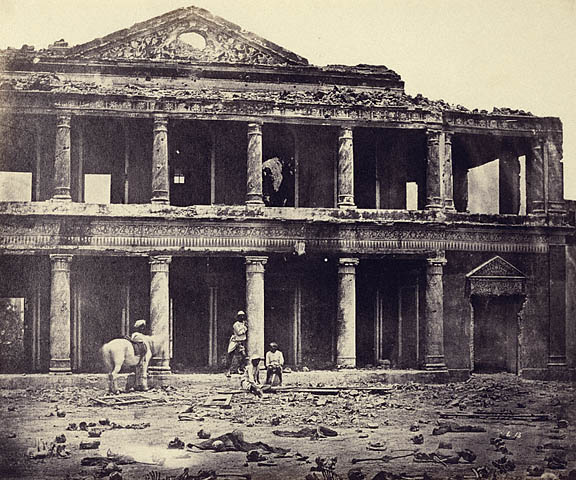Image-Secundra Bagh after Indian Mutiny higher res
Interior of the Secundra Bagh after the Slaughter of 2,000 Rebels by the 93rd Highlanders and 4th Punjab Regiment. First Attack of Sir Colin Campbell in November 1857, Lucknow. Albumen silver print, by Felice Beato, 1858.
Located on the outskirts of Lucknow, it was the scene of intense fighting in November, 1857. Following the action, the British dead were buried in a deep trench but the Indian corpses were left to rot. Later, the city had to be evacuated and was not recaptured until March 1858 and it was shortly afterwards that Beato probably took this photograph. As one contemporary commentator described it: "A few of their [rebel] bones and skulls are to be seen in front of the picture, but when I saw them every one was being regularly buried, so I presume the dogs dug them up." A British officer, Sir George Campbell, noted in his memoirs Beato's presence in Lucknow and stated that he probably had the bones uncovered to be photographed. However, William Howard Russell of The Times recorded seeing many skeletons still lying around in April 1858
Photographic views of Lucknow taken after the Indian Mutiny, Albumen silver print 26.2 x 29.8 cm. The image was taken by Felice Beato, a Corfiote by birth, who visited India during the period of the Indian Mutiny or First War of Indian Independence; possibly on a commissioned by the War Office in London he made documentary photographs showing the damage to the buildings in Lucknow following the two sieges. It is known that he was in Lucknow in March and April of 1858 within a few weeks of the capture of that city by British forces under Sir Colin Campbell. His equipment was a large box camera using 10" x 12" plates which needed a long exposure, and he made over 60 photographs of places in the city connected with the military events. Beato also visited Delhi, Cawnpore and other 'Mutiny' sites where he took photographs.[https://web.archive.org/web/20071222051622/http://www.brown.edu/Facilities/University_Library/collections/askb/beato/beato.html Anne S. K. Brown Military Collection:
Photographic views of Lucknow taken after the Indian Mutiny]Relevante Bilder
Relevante Artikel
Belagerung von LucknowDie Belagerung von Lucknow ist ein Ereignis des Indischen Aufstands von 1857 und neben der Belagerung von Kanpur aus britischer Sicht eines der beiden großen Opferdramen des von den Briten niedergeschlagenen Aufstands. Die Garnison wurde von Anfang Juni bis zum 18. November von Briten gegen eine Übermacht von aufständischen Truppen und indischen Zivilpersonen verteidigt. Danach fiel Lucknow zunächst wieder in indische Hand. Die abseits der Grand Trunk Road liegende Garnisonsstadt wurde wegen ihres hohen symbolischen und strategischen Wertes am 15. März 1858 von britischen Truppen unter Führung von Sir Colin Campbell wieder eingenommen. .. weiterlesen
Sikandar BagSikandar Bag ist ein Park mit einer Villa, der sich im Randbezirk von Lakhnau, Uttar Pradesh, Indien befindet. Das Gebäude wurde vom Nawab von Oudh, Wajid Ali Shah (1822–1887), als Sommerhaus errichtet. Die Anlage trägt den Namen der Lieblingsfrau des Nawabs, Sikander Mahal Begum. Das Gebäude und Grundstück wird heute vom National Botanical Research Institute von Indien genutzt. .. weiterlesen




